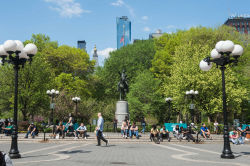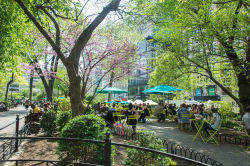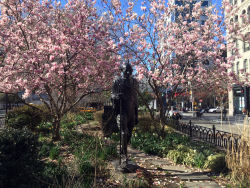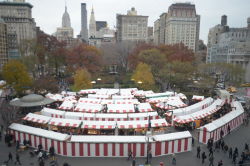Union Square Park
The Daily Plant : Monday, June 30, 2003
CENTRAL TO THE CITY: MANHATTAN SQUARES
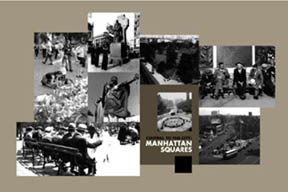
One of the most puzzling theorems in geometry is "all squares are rectangles, but not all rectangles are squares." The Arsenal Gallery’s newest exhibit, Manhattan Squares, offers a new corollary: "All Manhattan squares are called squares, though they might actually be triangles and ellipses." In celebration of these variously shaped public spaces, the Arsenal Gallery is currently displaying 96 archival and contemporary photographs, vintage postcards, historic renderings, artifacts, and memorabilia representing the role Manhattan’s 40 squares have played in the life of the City.
Manhattan’s squares were its first parks, the predecessor to the biggest "square" of all, Central Park. Ranging in size from 1000th of an acre to 20 acres, they are dispersed throughout Manhattan’s central business districts and residential enclaves. Over the years, Manhattan’s squares were used for outdoor markets, military exercises, political rallies, music, college commencements, and countless receptions, celebrations and vigils. They contain more than 40 of Parks & Recreation’s finest sculptures and have been the scene of historical milestones, from the display of the Statue of Liberty’s torch in Madison Square (1876) to the first Labor Day Parade (1882) in Union Square to the September 11th vigils following the attacks on the World Trade Center. The photographs and drawings displayed in Manhattan Squares illustrate how these first parks evolved over the years and helped to define what parks would and could be throughout the City.
Before Central Park, Manhattan’s squares were essentially the only parks in the center of the City, and the oldest images in the exhibit are among the most interesting. Early maps illustrate the foresight of City administrators who anticipated the eventual development of all of Manhattan, and the importance of carving our public space. Historic prints, plans, renderings and postcards define a transcendent New York in the late 19th and early 20th centuries, as elegant squares were newly landscaped and opened up for more democratic use. Photographs of a workers’ rally and the first Earth Day in Union Square are among the images that depict some of the first instances of social activism in Manhattan’s squares.
The exhibit also displays images which emphasize the way these squares are still evolving and changing today. Several squares have recently been expanded into adjacent streets, including Union, Foley and Verdi Squares. Herald and Greeley Squares have witnessed a startling revival achieved by more hospitable design, lavish horticulture, improved security and programming. In the financial district, plans are underway to reinterpret venerable Hanover Square as a British commemorative garden. And throughout the City, business improvement districts, conservancies, and volunteer grassroots organizations are working to bring about a renaissance of Manhattan’s squares, so that they may continue to flourish and remain central to the City.
Most of the images on display are from the New York City Parks & Recreation Photo Archive and Map File Collections; additional images are on loan from the New York Historical Society, the Art Commission of the City of New York, Miriam Berman, New York Bound, Robert McCabe, Catha Rambusch, Greenmarket, and William Cohen. Manhattan Squares was funded with generous donations from American Lawyer Media and Sunoco. Curated by Jonathan Kuhn and Patricia Hamilton, Manhattan Squares will be on view from June 19 - September 5, 2003.
PARKS & RECREATION MOURNS THE LOSS OF
RONALD CIANCIULLI
Former Queens Borough Commissioner Ronald Cianciulli passed away last Tuesday, June 24th. Cianciulli began his career at Parks in 1963 as Assistant Gardener in Rockaway, and became the Borough Commissioner for Queens in 1995. A memorial service was held on Wednesday, June 25th at the OB Davis Funeral Parlor. Instead of flowers, the family requests that donations be made to the American Cancer Society. Ronald Cianciulli is survived by his wife, four children, and eight grandchildren.
QUOTATION FOR THE DAY
"The older I grow the more I distrust the familiar doctrine
that age brings wisdom."
H.L. Mencken
(1880-1956)
Check out your park's Vital Signs
Clean & Safe
Green & Resilient
Empowered & Engaged Users
Share your feedback or learn more about how this park is part of a
Vital Park System

